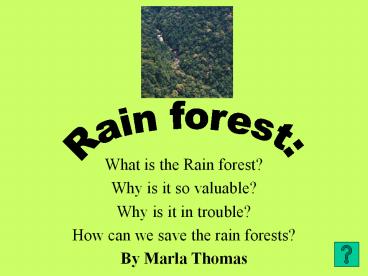What is the Rain forest? - PowerPoint PPT Presentation
Title:
What is the Rain forest?
Description:
What is the Rain forest? Why is it so valuable? Why is it in trouble? How can we save the rain forests? By Marla Thomas What is the Rain forest? Why is it so valuable? – PowerPoint PPT presentation
Number of Views:140
Avg rating:3.0/5.0
Title: What is the Rain forest?
1
Rain forest
- What is the Rain forest?
- Why is it so valuable?
- Why is it in trouble?
- How can we save the rain forests?
- By Marla Thomas
2
What is the Rain forest?
3
WHAT IS A RAIN FOREST? On the outside, a rain
forest has a wall averaging 20 feet thick that is
made of a tangle of vines that love light. This
wall seals off the interior creating the illusion
that the whole jungle is this thick. But if you
find an animal path or stream to follow, you can
slip through and enter this mysterious
world. Once you're inside, you can look up and
see a tree canopy that's as high as a 17 story
building! And it's pretty dark too, a perpetual
twilight. Only 1 of the sunlight ever actually
touches the floor of the forest. And moonlight,
even a full moon, doesn't get through at all.
You'd better have a flashlight with you if you
plan on reading any comics. Rain forests have
different layers that support different animals
and insects. Some plants and animals occupy
specific layers, while others live and feed
wherever they can.
4
Special Creatures
DWARF CAIMAN
MACAWS
CAPYBARA
5
ZOG-ZOG
More Creatures
PECCARY
6
Why is the rain forest so valuable?
7
- Why is the Rain Forest so Valuable?
- Fifty percent of the medicines used in the world
every day come from rain forest plants. And 25
of all prescription drugs have their origins
there too. - The corn plant originally came from Mexico and
South American rain forests. - Rice has its origins in Asian rain forests.
- Orange juice, tea, eggs, and bananas all
originated from plants and animals of Asian rain
forests. - Over 50 of the fruits you eat regularly
originally came from tropical rain forests. - Sugar originated in the rain forests of India,
while pineapple from Venezuelan rain forests.
Cocoa and chocolate both originated in Central
and South American rain forests. And coffee's
origins can be traced to an Ethiopian rain
forest.
8
Products we get with help from rain forest
resources...
9
Why is the Rain forest in trouble?
10
The Rain Forest is in Trouble In addition to
being one of our most precious natural resources,
tropical rain forests are among the most
endangered habitats on earth. It is vital that
everyone understands how important forests are.
If we destroy them, we are in danger of causing
great havoc on the planet. Causes of
Deforestation clearance for roads
and railways forest fires
mining and drilling for fuel wood
international timber trade
collection and clearance for living space
Humans already have destroyed half of the rain
forest area, with most damage occurring in the
last 200 years.
11
How can we save the rain forests?
12
- WATCH OUT FOR OUR EARTTH
- WAYS THAT YOU CAN HELP TO SAVE THE RAIN FOREST
- Write letters to your senators and
representatives to let them know that you are
concerned about rain forest destruction. Ask that
they support programs that help protect tropical
areas throughout the world. - Make personal contact with people in tropical
countries to better understand what their life is
like. Become a pen pal, or make a visit!
13
- WATCH OUT FOR OUR EARTTH
- MORE WAYS THAT YOU CAN HELP TO SAVE THE RAIN
FOREST - Raise money to support programs that help
protect the world's rain forests. Organize a
fund-raising party with tropical food and music.
Plant trees in your own community to remind
people of tropical forest destruction. - Go in with some friends and buy an acre of rain
forest. The Nature Conservancy's "Adopt-an-Acre
Program" lets you purchase the protection of an
acre of rain forest in a specific nature preserve.
14
- WATCH OUT FOR OUR EARTTH
- MORE WAYS THAT YOU CAN HELP TO SAVE THE RAIN
FOREST - Buying rain forest foods gives people living in
rain forests a reason to keep forests intact,
instead of cutting them down to raise other
foods, like grains or cattle. - Turn off the lights or TV when you leave a room
- Recycle paper, cardboard, plastic, glass,
metals--everything you can! - Walk or ride your bike instead of driving.
15
Be Thinking of What You Have Learned About the
Rain forest...
16
What will you do based on the information that
you have learned? Explain your thinking.































